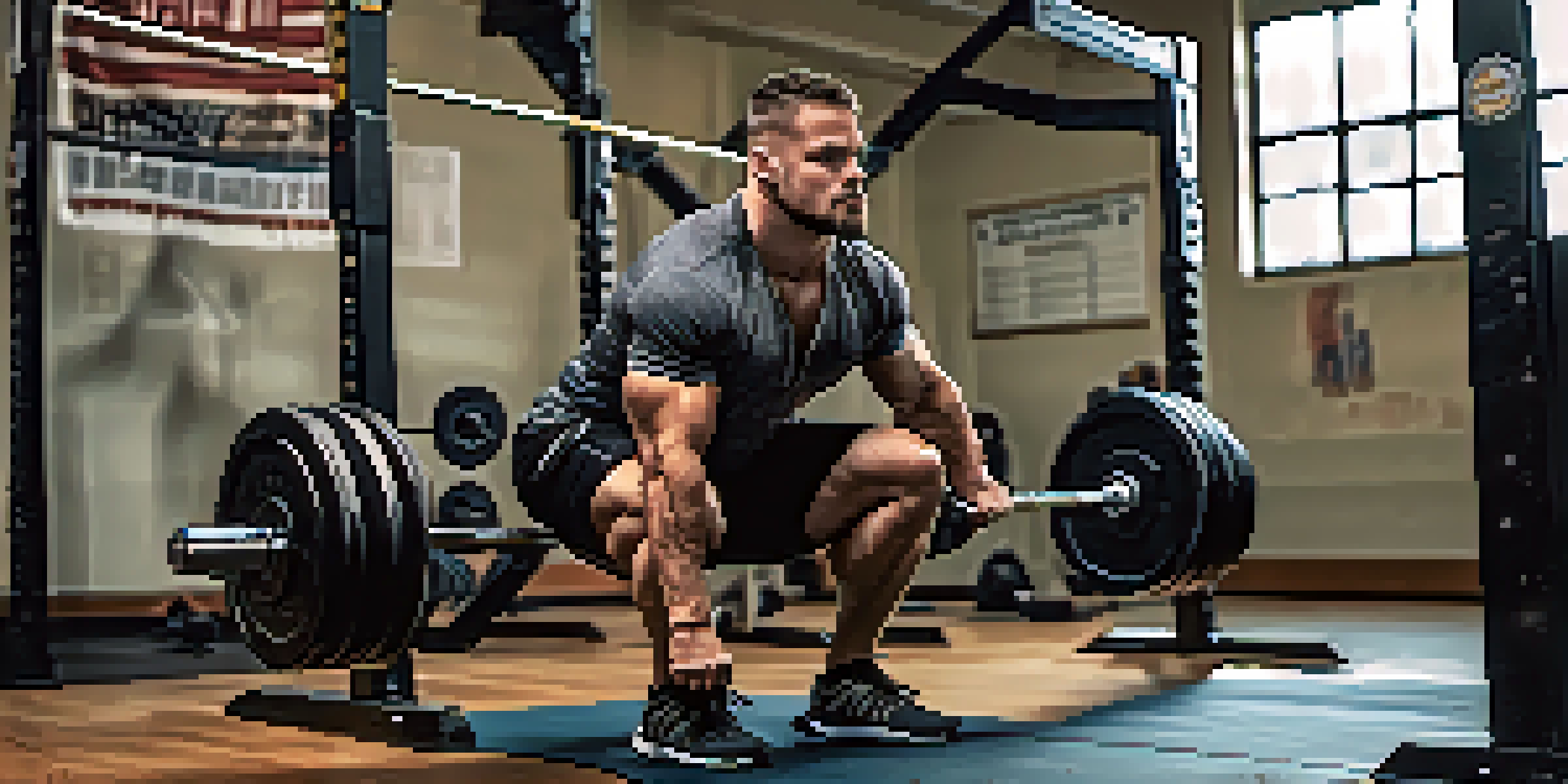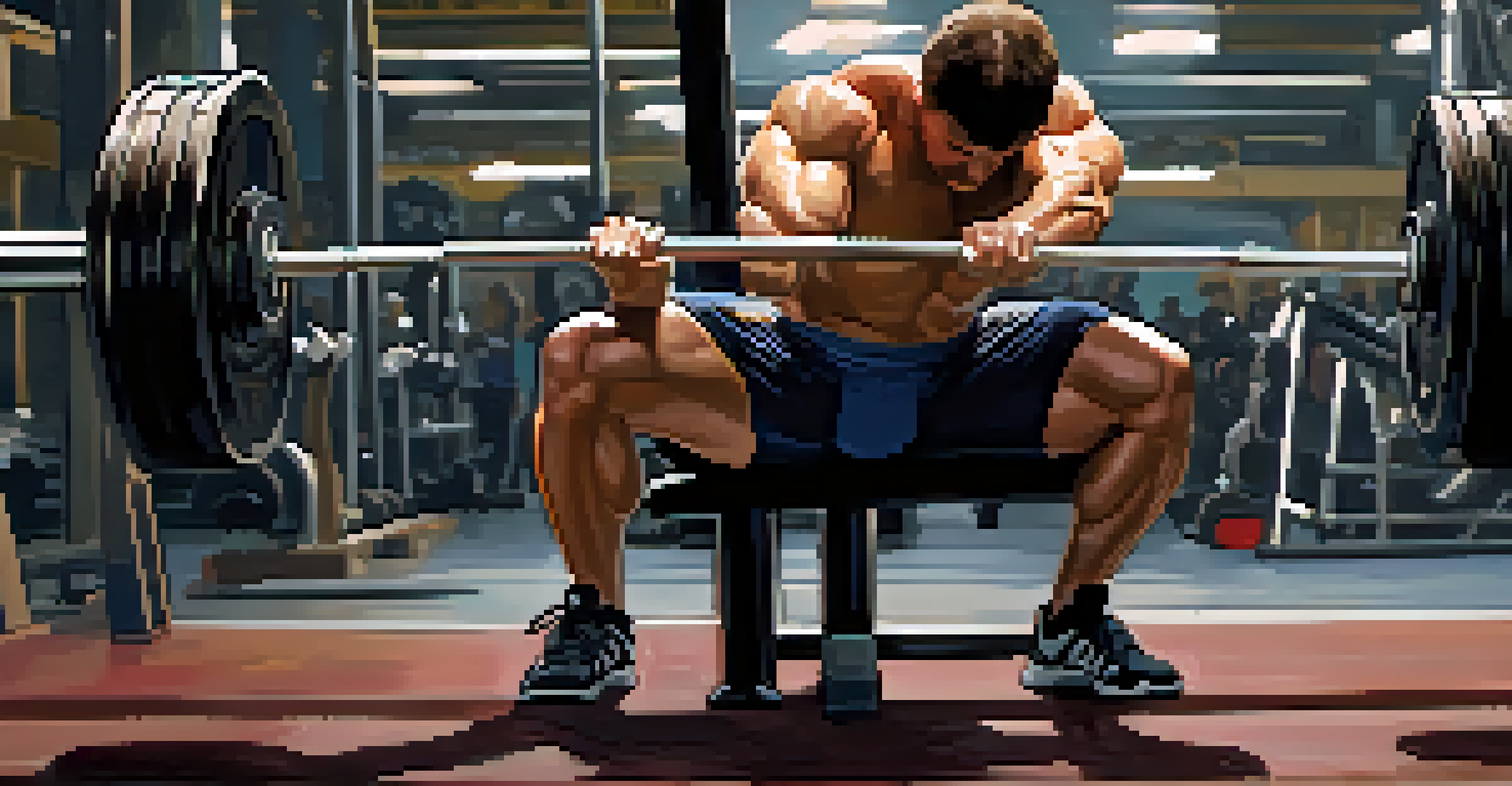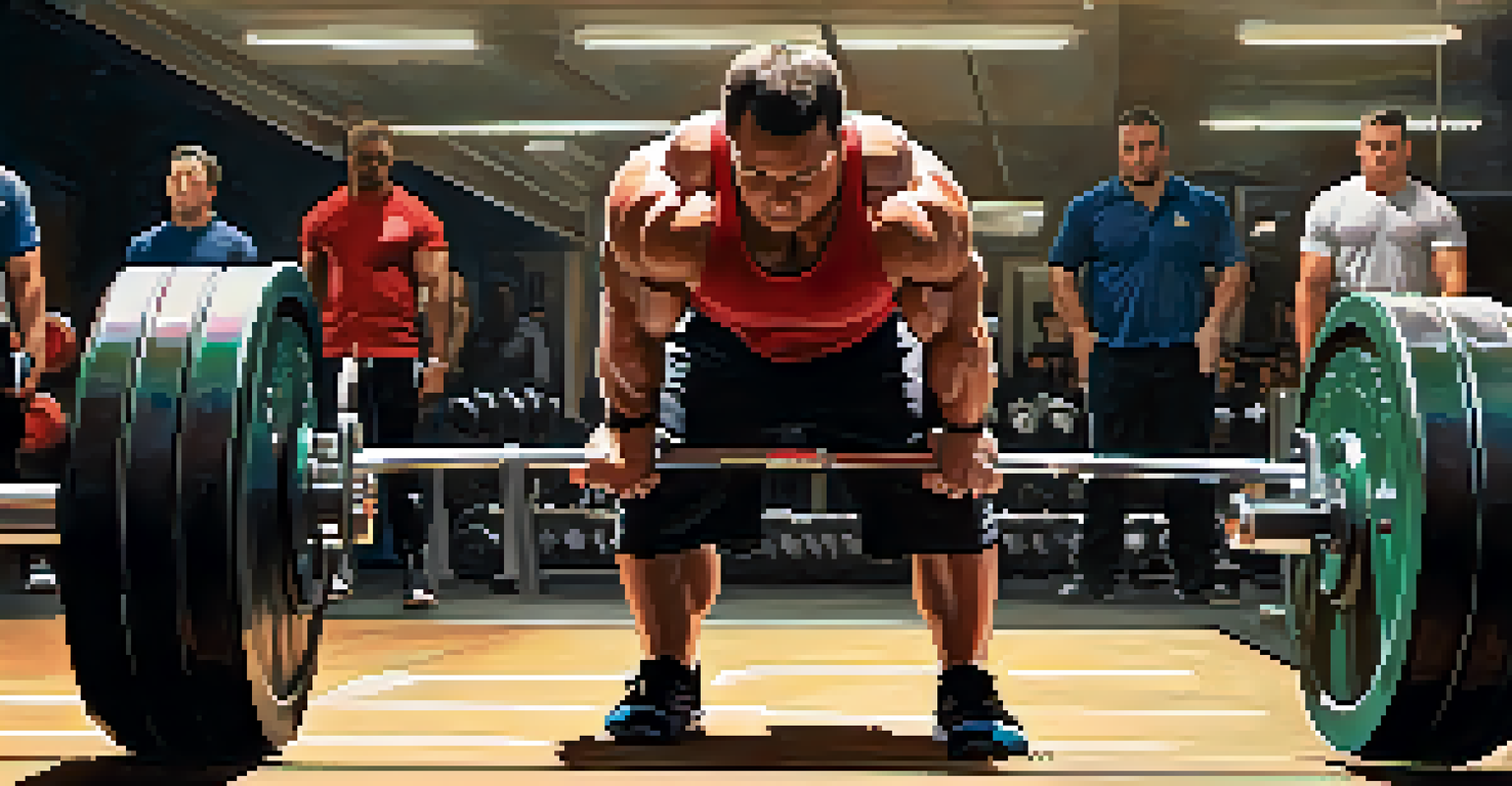Essential Powerlifting Exercises for Beginners

Understanding Powerlifting: The Basics Every Beginner Needs
Powerlifting is a strength sport that focuses on three main lifts: the squat, bench press, and deadlift. Each lift tests different muscle groups and offers unique benefits, making them essential for building overall strength. For beginners, grasping the fundamentals of these lifts is crucial for safety and effectiveness.
Strength does not come from physical capacity. It comes from an indomitable will.
The beauty of powerlifting lies in its simplicity; it’s about lifting as much weight as possible in these three exercises. This straightforward approach allows beginners to track progress easily, which can be incredibly motivating. Plus, mastering these lifts lays the groundwork for more advanced training down the road.
As you embark on your powerlifting journey, remember that form is key. Proper technique not only maximizes your gains but also reduces the risk of injury, ensuring you stay on track toward your goals. So let’s dive into each exercise and explore why they are essential for every beginner.
The Squat: Building Leg Strength and Stability
The squat is often considered the king of all exercises. It primarily targets your quadriceps, hamstrings, and glutes, but it also engages your core and lower back, making it a full-body workout. For beginners, mastering the squat is essential, as it builds a strong foundation for overall strength.

When performing a squat, it’s important to keep your feet shoulder-width apart, with your toes slightly pointed outward. As you lower your body, aim for your thighs to be parallel to the ground, ensuring your knees don’t extend past your toes. This form not only maximizes effectiveness but also minimizes the risk of injury.
Master the Three Main Lifts
Understanding and mastering the squat, bench press, and deadlift is essential for building a strong foundation in powerlifting.
Incorporating squats into your routine will help you develop better balance and stability, which are crucial for other powerlifting lifts. Start with bodyweight squats to perfect your form, then gradually add weight as you gain confidence and strength. Remember, consistency is key!
The Bench Press: Upper Body Strength Simplified
The bench press is a staple in powerlifting, focusing on your chest, shoulders, and triceps. It’s not just about pushing weight; it’s about mastering the mechanics of the lift. For beginners, understanding the proper setup and technique is vital to avoid injury and maximize gains.
The difference between a successful person and others is not a lack of strength, not a lack of knowledge, but rather a lack in will.
To perform a bench press, lie flat on a bench with your feet planted firmly on the ground. Grip the barbell slightly wider than shoulder-width, and lower it to your chest before pressing it back up. Keep your elbows at about a 45-degree angle to protect your shoulders and ensure optimal force generation.
As you progress, consider incorporating variations like incline and decline bench presses to target different areas of your chest. Remember, like with squats, form is crucial; focus on controlled movements rather than just lifting heavy weights. This approach will lead to better results in the long run.
The Deadlift: A Full-Body Powerhouse Exercise
The deadlift is another key player in the powerlifting trio, engaging multiple muscle groups, including your back, legs, and core. It’s a functional exercise that mimics movements we perform in daily life, making it not only practical but also essential for building overall strength. For beginners, understanding the nuances of the deadlift is crucial for safe lifting.
To execute a deadlift, stand with your feet hip-width apart and grip the barbell with both hands just outside your knees. As you lift, focus on keeping your back straight and engaging your core to prevent injury. The movement should be initiated by driving through your heels and extending your hips forward at the top.
Importance of Consistency
Establishing a regular training routine and setting realistic goals are key to long-term success in powerlifting.
Deadlifts can be intimidating, but starting with lighter weights will help you build confidence and perfect your form. As your strength increases, you can gradually add weight. Remember, this exercise not only enhances your strength but also improves your posture, which is a win-win!
The Importance of Accessory Exercises for Beginners
While the squat, bench press, and deadlift are the main lifts, accessory exercises play a vital role in building strength and preventing injuries. These exercises target specific muscle groups that assist in the primary lifts, helping to create a balanced physique. For beginners, incorporating accessory movements can enhance overall performance.
Examples of accessory exercises include lunges for leg strength, rows for upper back stability, and planks for core strength. By integrating these movements into your routine, you’ll develop the supporting muscles necessary for a stronger performance in your main lifts. Plus, they add variety to your training, keeping it fresh and exciting.
Remember, balance is key in powerlifting. While focusing on your main lifts, don’t forget to pay attention to the smaller muscle groups that contribute to your overall strength. This holistic approach will not only improve your performance but also help prevent injuries in the long run.
Establishing a Consistent Training Routine
Consistency is the backbone of any successful powerlifting journey. Establishing a regular training routine helps you build strength over time and allows you to track your progress effectively. For beginners, it’s essential to set realistic goals and create a schedule that fits your lifestyle.
Consider training three to four times a week, focusing on the main lifts and accessory exercises. This frequency allows for adequate recovery while still challenging your muscles. Additionally, tracking your workouts in a journal or an app can provide valuable insights into your progress and motivation.
Nutrition Fuels Performance
A balanced diet rich in protein, healthy fats, and complex carbohydrates is crucial for maximizing strength gains and recovery.
Staying consistent doesn’t mean you can’t mix things up! Incorporate different variations of the main lifts and adjust your accessory exercises to keep your workouts engaging. Remember, progress takes time, so be patient and celebrate small victories along the way.
The Role of Nutrition in Powerlifting Success
Nutrition is a crucial component of any strength training program, including powerlifting. Fueling your body with the right nutrients helps you perform at your best and recover effectively. For beginners, understanding the basics of nutrition can significantly impact your strength gains.
Focus on a balanced diet rich in protein, healthy fats, and complex carbohydrates. Protein is particularly important for muscle repair and growth, so aim to include sources like chicken, fish, beans, and dairy in your meals. Don’t forget to hydrate; water plays a vital role in overall performance and recovery.

As you progress in your powerlifting journey, consider consulting a nutritionist or doing some research to tailor your diet to your specific needs. Remember, what you put into your body is just as important as the training you do. A well-rounded approach to nutrition and training will set you up for long-term success.
Tracking Progress and Staying Motivated
Tracking your progress is crucial in powerlifting, as it helps you see how far you’ve come and where you need to improve. Keeping a training log, noting your weights, sets, and reps, provides a clear picture of your development. For beginners, this practice can also boost motivation and accountability.
Set specific, measurable goals for each lift, whether it’s adding weight or improving form. Celebrate your achievements, no matter how small, as this positive reinforcement will keep you motivated. Additionally, consider finding a workout buddy or joining a community to share your journey and stay encouraged.
Remember, progress isn’t always linear. There will be ups and downs, but maintaining a positive mindset and staying committed to your training will yield results over time. Embrace the journey, and enjoy every step of the way as you grow stronger.